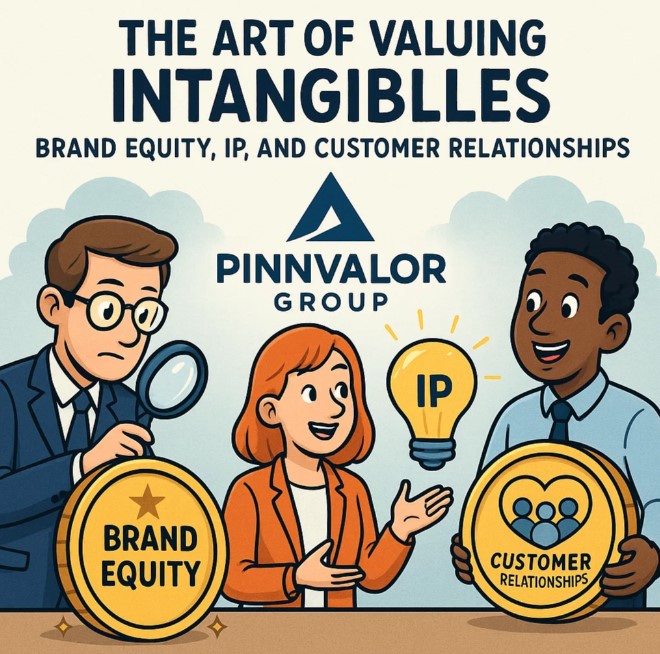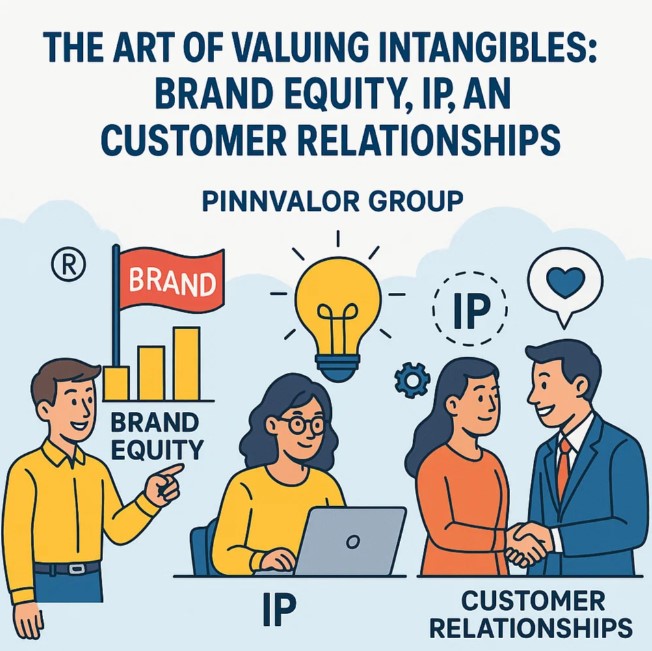
The Art of Valuing Intangibles: Brand Equity, IP, and Customer Relationships
In today’s knowledge-driven economy, the true value of a business often lies in what you can’t see on the balance sheet. Intangible assets like brand equity, intellectual property (IP), and customer relationships play a pivotal role in driving long-term profitability, competitive advantage, and enterprise value.
Yet, valuing these intangibles is often more of an art than a science. This article explores the key principles, methods, and considerations involved in valuing three of the most critical types of intangible assets.
What is your brand, IP, or customer list really worth — and how can you prove it?
IntangibleAssets are the invisible drivers of real business value—far beyond what balance sheets can show.
1. Understanding Intangible Assets
Intangible assets are non-physical assets that contribute to a business’s ability to generate income. They are often created over time and can be internally developed or acquired.
Common categories include:
- Brand Equity
- Intellectual Property (Patents, Trademarks, Copyrights)
- Customer Lists & Relationships
- Proprietary Technology
- Goodwill
Unlike tangible assets, these are harder to quantify and require more nuanced valuation approaches.
2. Why Valuation of Intangibles Matters
- M&A and Deal Structuring: Buyers want to know what they’re really paying for.
- Financial Reporting: Compliance with accounting standards (e.g., IFRS, Ind AS, US GAAP) requires fair value measurement of acquired intangibles.
- Tax Planning & Transfer Pricing: Assigning value to intangibles helps optimize tax strategy, especially in cross-border transactions.
- Litigation or Dispute Resolution: Valuation supports damage estimation or IP infringement cases.
- Licensing & Commercialization: Knowing the value helps in negotiation of royalty rates and licensing terms.
3. Valuing Brand Equity
Brand equity represents the value a brand adds to a product or company. Strong brands influence customer behavior, command premium pricing, and build loyalty.
Common methods:
- Relief-from-Royalty Method: Estimates value based on hypothetical royalty payments saved by owning the brand rather than licensing it.
- Income Approach: Projects future cash flows attributable to the brand, discounted to present value.
- Cost Approach: Calculates historical costs of developing and maintaining the brand.
- Market Approach: Based on comparable brand sales or licensing transactions (less commonly used due to lack of direct market comparables).
Key Factors: Brand recognition, customer perception, market leadership, longevity, and marketing spend.

4. Valuing Intellectual Property (IP)
IP includes patents, trademarks, copyrights, trade secrets, and design rights. Each type of IP offers a unique form of legal protection and commercial advantage.
Valuation Approaches:
- Income Approach: Most widely used, especially for patents and copyrights. Calculates expected future income attributable to the IP.
- Relief-from-Royalty: Used extensively for trademarks and software IP.
- Market Approach: Useful if there are active licensing or transaction markets.
- Cost Approach: Applies best to early-stage or non-commercialized IP.
Key Considerations: Legal life vs. economic life, exclusivity, scalability, enforceability, and the stage of development (especially for patents).
5. Valuing Customer Lists & Relationships
Customer-related intangibles include customer lists, contracts, relationships, and customer loyalty. These assets often provide recurring revenue and reduced acquisition costs.
Common Valuation Methods:
- Multi-period Excess Earnings Method (MEEM): Measures net earnings attributable solely to the customer base, after deducting contributions of other assets.
- With-and-Without Method: Compares business value with and without the customer list.
- Cost-to-Recreate: Rare, but used for contact databases or CRM data.
Key Drivers: Retention rates, customer concentration, contract length, historical revenue patterns, and cross-sell potential.
6. Challenges in Intangible Valuation
- Lack of Observable Market Data: Many intangibles are unique.
- Subjectivity: Requires assumptions about future performance, discount rates, and asset-specific risks.
- Legal and Regulatory Complexity: Different accounting and tax treatments across jurisdictions.
- Overlap of Intangibles: For example, brand and customer relationships often contribute to the same revenue stream.
7. Best Practices for Accurate Valuation
- Use multiple approaches to triangulate a fair value.
- Align assumptions with industry benchmarks and financial models.
- Document all inputs and methodologies for audit or legal defensibility.
- Involve cross-functional expertise: finance, legal, marketing, and operations teams.
- Update valuations periodically, especially when major business events occur.
Conclusion
Intangible assets may be invisible—but they’re far from insignificant. In many industries, they represent the majority of a company’s value. Whether you’re preparing for a transaction, complying with accounting standards, or optimizing your tax position, understanding how to value intangibles like brand equity, IP, and customer relationships is critical.
Mastering this art doesn’t just enhance your financial insights—it can unlock substantial strategic value.
